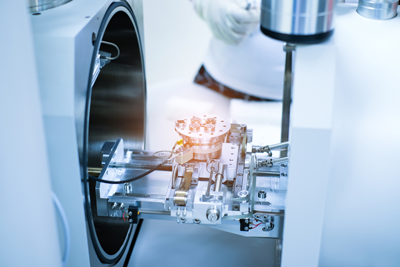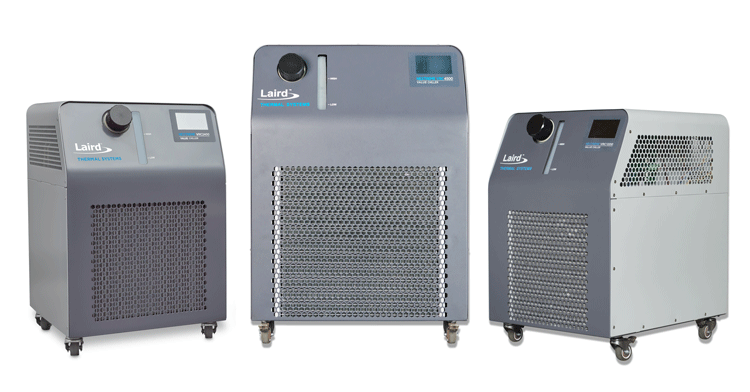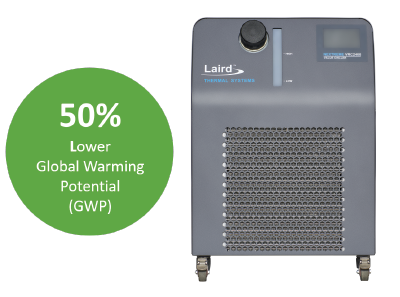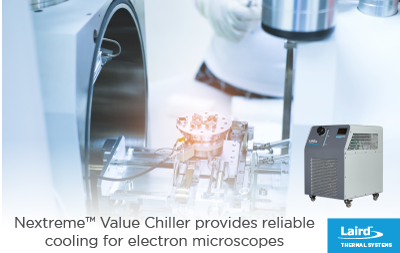Introduction
Electron microscopes are powerful laboratory tools used to observe samples across many scientific disciplines. These advanced analytical instruments enable researchers to qualitatively and quantitatively analyze samples in fields like metallography, metrology, anthropology, zoology, epidemiology and more. Temperature control plays a dynamic role in ensuring the proper operation of electron microscopes. This includes sample temperature stabilization (read the Heating and Cooling of Incubator Chambers application note), as well as thermal control of sensitive equipment electronics. Thermal fluctuations can degrade the quality of the microscopic imaging, and lead to a break down in the composition of the sample under examination.
Compressor-based chillers with integrated temperature control offer OEMs a cost-effective and efficient advanced thermal management solution that keeps sensitive electronics in their lab equipment designs at the optimum temperature. Moreover, new industry restrictions on hazardous refrigerants central in traditional chiller technology require electron microscope manufacturers to find more environmentally friendly, efficient and maintenance-free temperature control options for their equipment. The eco-friendly Nextreme™ Value Chiller quietly cools temperature-sensitive components below ambient temperature to ensure optimum image quality.

Lab instrumentation tools such as electron microscopes require an advanced thermal management solution
for precise temperature control of electronics and samples.
Background
An electron microscope uses a beam of accelerated electrons to illuminate the ultrastructure of a wide range of biological and inorganic specimens including microorganisms, cells, large molecules, biopsy samples, metals, and crystals. There are several types, each with different configurations and techniques for analyzing specimens. However, all electron microscopes use a high-voltage electron beam to illuminate a specimen and create an image. The electron beam is produced by an electron gun.
OEMs implement thermal management systems that cool the digital cameras used for image creation to improve image quality. Active cooling is required to deliver optimal image resolution independent of the operating environment. In addition, advanced electron microscopes also have temperature control functionality for the specimen holder.
The electron beam can be controlled or manipulated via a magnetic field according to the “left-hand” rule. Electromagnets create a magnetic field that allows for the formation of a magnetic lens of variable focusing power. The coils, which produce the magnetic field, are located within the lens yoke. The coils can contain a variable current but typically use high voltages and therefore require significant insulation in order to prevent short-circuiting the lens components. These coil windings require a thermal management solution to remove the heat generated when creating the magnetic field.
Application Challenges
Designers face a number of thermal challenges when developing electron microscopes. As mentioned, several key microscope components, including the image recording electronics, the electromagnetic coils, and the sample port require stable thermal control below ambient temperatures. To go below ambient temperatures, refrigeration systems are required. This isn’t possible with other cooling technologies like liquid heat exchangers, which uses air to cool a cooling loop.
In addition to meeting thermal control requirements for these three electron microscope elements, cooling solutions must also meet smaller size, lighter weight and reduced power consumption requirements. To optimize customers’ lab space, OEMs look for ways to decrease device size while increasing device functionality. As a result, more electronics are packaged into smaller housings, increasing the heat flux density and thermal challenges. This waste heat must be managed and dissipated efficiently in order to enhance the imaging capability of the electron microscope, while reducing power consumption and providing quieter operation (both lower noise and vibration).
Electron microscopes are sensitive to disturbances, such as vibration, in the surrounding environment. Some liquid pump models cause more vibration as a result of higher pulsations in the fluid lines. This is the case with a rotary vane pump and some centrifugal pumps. Turbine pumps have significantly less pulsation, which enables better imaging by the microscope.
The thermal management system needs to provide condensation protection for the electronic microscopes. Moisture forms on cold surfaces as temperature drops below the dew point. If this moisture seeps into the electronics, or onto the lenses, it can affect image quality and may even cause deterioration and ultimately failure of the electronics. Using properly designed insulation materials can provide a cooling solution resistant to moisture intrusion.
Electron microscopes must follow UL61010-1 or IEC 61010-1 lab safety standards. These standards ensures safety of the operators and include specifications for electromagnetic compatibility and electromagnetic emissions to ensure electron microscopes can operate in the same room as other electronic equipment without interference. When designing an electron microscope, OEMs either ask for a certification from the chiller manufacturer or certify it themselves as part of the installed system.
In addition, many governments continue to develop strict environmental legislation aimed at curbing climate change, which restricts usage of refrigerants in several refrigeration and freezer systems. The phase-down on environmentally harmful refrigerants, like HFC refrigerants including R134a and R404A, has led to the development of new, eco-friendly refrigeration systems. These systems use natural refrigerants that have a reduced eco-footprint. However, the flammable nature of some natural refrigerants can make them hazardous to transport, and each one presents design challenges such as increased pressure, high toxicity, flammability, asphyxiation, and relatively poor performance. Another restriction in Europe is ROHS
(Reduction of Hazardous Substance), which means that you cannot use lead, mercury, cadmium and other heavy metals in electronic products.
Comparing Cooling Technologies
Modern compressor-based liquid cooling systems meet the electron microscope design requirements mentioned above. Compressor-based liquid cooling systems, which are self-contained units that recirculate coolant to a predefined temperature set-point, allow for optimal thermal stabilization and more precise temperature control. Standard and custom liquid cooling systems are able to dissipate the large amount of heat generated in densely packed electronic environments like electron microscopes.
Compressor based refrigeration systems offer a high coefficient of performance (COP). If they are cooling a heat load of 3 kW, they only require 1 kW of energy to do the work to cool it. Compressor-based systems tend to be smaller than alternative technologies like liquid-air-heat exchangers when achieving set-points near ambient temperatures because they make use of the refrigerant’s latent energy to increase heat exchanger efficiency.
If the product is operating in ambient temperature, liquid-heat-exchangers are more efficient. However, liquid-to-air heat exchangers do not cool below ambient like compressor-based and thermoelectric systems.
Central facility cooling systems are another option previously used to cool electron microscopes. Since these systems are used to cool equipment in the entire building, it can be difficult to satisfy all of the instrumentation’s cooling requirements with one centrally controlled system. In addition, it cannot guarantee a constant temperature and flow rate.
Laird Thermal Systems Solution
The Nextreme Value Chiller Series from Laird Thermal Systems offers reliable, cost-efficient temperature control. Based on the design for the Nextreme Performance Chiller Series, the Value line offers the same ease of use, high reliability, and low maintenance features as the Performance Series but at a lower cost through materials (brass instead of stainless steel), simpler components (single speed instead of variable speed compressor) and different control system (switches instead of sensors). This provides more competitive pricing to OEMs looking for a packaged solution with their instrument. Most importantly, the Nextreme Value Chillers can be configured and engineered to meet unique requirements for analytical and medical applications.
The Nextreme Value Chiller Series uses high-performance, compressor-based technologies to cool equipment well below ambient temperatures and dissipate heat away from thermally sensitive equipment. The chillers from the value series offer a high coefficient of performance (COP) and can maintain a thermal set point with an accuracy of ±0.5°C in the supply coolant. Available in a footprint as small as 19.0 x 22.1 inches the Nextreme Value Chillers are smaller than most conventional cooling solutions.
The Nextreme Value Chiller Series is available in three standard models, 1200, 2400, and 4500 Watts. All these models can be configured to meet specific application requirements.

The Value Chiller products offer a lower cost of ownership and ease of use through:
- High reliability
- Pump technology with no-wear components
- Low fluid pulsation
- Capability of high pressure at rated flows
- Filtration and flow options
- Prevention of evaporative losses and bio-fouling
- Lower investment cost and added installation flexibility with the standard system
- Increased uptime
- Improved alarm condition detection
- Remote communication protocol for requesting data or send setpoints
- User-settable pressure limits to prevent equipment damage
The easy-to-use, LCD color touchscreen display comes standard and provides a simple user interface that communicates system status without the need for alarm codes or symbols. It allows the technician to control temperature setpoints, coolant type, pressure, and alarm settings while coolant level is easily monitored through the indicator window located on the front panel.
A semi-closed fluid system with pressure/vacuum reservoir cap prevents evaporative losses, the introduction of bacteria, and eliminates the need for additional hardware to prevent fluid drain-back. Other products on the market use an open/vented system that is simple to install and use but requires increased maintenance and monitoring of fluid levels and coolant quality. With the added functionality in the Value Chiller’s reservoir cap, less time is required to maintain system operation and uptime, and higher fluid quality level allows longer life of critical components like the pump, heat exchangers, and sensors.
Other standard features include optical fluid level-sensing with no moving parts; RS-232/Ethernet communications for integration into higher-level assembly control systems; and supply pressure sensing. Optional features include a hot-swappable, 5-micron water filter for filtering particulates from the coolant circuit and flow control valve and sensor to reduce and measure overall flow to the application (full flow continues through the chiller to maintain high heat transfer rates and temperature stability).
 Using environmentally friendly R513A refrigerant, the Nextreme Value Chillers achieve similar performance with half the Global Warming Potential (GWP) compared to traditional hydrofluorocarbon (HFC) refrigerants. The chillers not only meet CE, REACH, and RoHS requirements but also UL61010-1 and IEC 61010-1 lab safety standards. While other chiller manufacturers require a different model for Europe and North America, Nextreme Value Chillers can be operated anywhere in the world. This allows OEMs to test equipment in one country before shipping to a different region. They also can carry less inventory as a single chiller can ship globally.
Using environmentally friendly R513A refrigerant, the Nextreme Value Chillers achieve similar performance with half the Global Warming Potential (GWP) compared to traditional hydrofluorocarbon (HFC) refrigerants. The chillers not only meet CE, REACH, and RoHS requirements but also UL61010-1 and IEC 61010-1 lab safety standards. While other chiller manufacturers require a different model for Europe and North America, Nextreme Value Chillers can be operated anywhere in the world. This allows OEMs to test equipment in one country before shipping to a different region. They also can carry less inventory as a single chiller can ship globally.
Most importantly, Laird Thermal Systems’ team works with OEMs to develop solutions that work best for their applications. Its design engineers can make modifications to the Value Chiller—such as supplying hose kits, modifying factory settings on the display, or changing out pump types—offering OEMs customized solutions with the cost and delivery times of off-the-shelf products. If the Value Chiller isn’t a fit for an OEM’s application, Laird Thermal Systems’ Thermal Wizard will help identify the right cooling solution that meets the application’s demands. Finally, Laird Thermal Systems supports OEM customers with high-mix products. Supply chain and production planning exceed industry standards with on-time delivery, so the OEM may carry low amounts of inventory and plan shipments on an as-needed basis with high confidence product will arrive on time.
The Value Chiller is a cost-effective, low-maintenance cooling solution that promises OEMs’ customers long-life component technology and system control that prevents failures, maximizing system uptime. This high reliability ensures end users experience fewer operational issues, increased throughput, and a better customer experience using OEMs’ equipment.
Conclusion
Properly cooling an analytic instrument like an electron microscope requires a sophisticated thermal management system. Modern compressor-based refrigeration systems are more advanced and efficient than previous versions. Compact chiller systems offer a higher coefficient of performance with maximum uptime and minimal power consumption compared to the application’s heat load. The versatile Nextreme Chiller provides quiet operation in a smaller and lighter package compared to previous models. The Nextreme recirculating chiller platform enables more focused and improved performance resulting in a precise image with better resolution.
More information on the Nextreme ValueChillers can be found by visiting
lairdthermal.com/nextreme-VRC1200
lairdthermal.com/nextreme-VRC2400
lairdthermal.com/nextreme-VRC4500

